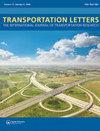Determination of the optimal connected and automated vehicles platoon size based on the merging success rate
IF 3.3
3区 工程技术
Q2 TRANSPORTATION
Transportation Letters-The International Journal of Transportation Research
Pub Date : 2024-09-13
DOI:10.1080/19427867.2023.2252220
引用次数: 0
Abstract
The platoon size is a critical parameter in connected and automated vehicle (CAV) platoon configuration. However, the optimal platoon size configuration for the mixed human-driven vehicles (HVs) and CAVs traffic has not been well-studied, especially in merging areas. This paper aims to determine the optimal platoon size in the merge area through numerical analysis. Specifically, the existing merge probability calculation model is improved considering the impact of mainline random platoon size on on-ramp vehicles. In the improved model, the CAV platoon is treated as a vehicle with different lengths, and the headway between the platoon and single vehicle and the headway between the platoons are related to the maximum platoon size and CAV penetration rate. Three key parameters, namely the CAV penetration rate, acceleration lane length, and mainline traffic volume, were combined at various values. Based on this input, the relationship between the success rate and the platoon size was analyzed. The numerical analysis results indicate that: (1) when the CAV penetration rate is 10% ~30%, the merge success rate increases and stabilizes as the platoon size increases, and the optimal platoon size is 4 ~ 6. (2) When the CAV penetration rate is 40% ~70%, the trend of merge success rate varies with increasing platoon size under different mainline traffic volumes and acceleration lane lengths. Under the situation with lower traffic and longer acceleration length, the merge success rate tends to decline easier with larger platoon sizes, with 3 ~ 8 being the optimal platoon size. (3) When the CAV penetration rate is 80% ~90%, as the platoon size increases, the merging success rate tends to increase to the highest point and decrease. The optimal platoon size is 3 ~ 5. Finally, the validity of the theoretical model is confirmed through simulation experiments, and its limitations are discussed.
基于归并成功率的网联与自动驾驶车辆最优队列大小确定
排规模是互联和自动驾驶车辆(CAV)排配置中的一个关键参数。然而,人类驾驶车辆(HVs)和 CAVs 混合交通的最佳排规模配置尚未得到充分研究,尤其是在并线区域。本文旨在通过数值分析确定并线区域的最佳排规模。具体来说,考虑到主线随机排数对匝道车辆的影响,对现有的并线概率计算模型进行了改进。在改进后的模型中,CAV 排被视为不同长度的车辆,排与单车之间的车头间距和排与排之间的车头间距与最大排规模和 CAV 渗透率相关。三个关键参数,即 CAV 渗透率、加速车道长度和主线交通量,以不同的值进行组合。在此基础上,分析了成功率与排规模之间的关系。数值分析结果表明(1)当 CAV 渗透率为 10% ~30% 时,并线成功率随着排数的增加而增加并趋于稳定,最佳排数为 4 ~ 6。(2) 当 CAV 渗透率为 40% ~70% 时,在不同的主线交通流量和加速车道长度下,并线成功率的变化趋势随排数的增加而变化。在交通流量较小、加速车道长度较长的情况下,并线成功率随排数增加而下降,3 ~ 8 排为最佳排数;在交通流量较小、加速车道长度较长的情况下,并线成功率随排数增加而下降,3 ~ 8 排为最佳排数。(3)当 CAV 渗透率为 80% ~ 90% 时,随着排数的增加,并线成功率趋于上升到最高点后下降。最佳排数为 3 ~ 5。最后,通过仿真实验证实了理论模型的正确性,并讨论了其局限性。
本文章由计算机程序翻译,如有差异,请以英文原文为准。
求助全文
约1分钟内获得全文
求助全文
来源期刊

Transportation Letters-The International Journal of Transportation Research
TRANSPORTATION SCIENCE & TECHNOLOGY-
CiteScore
6.40
自引率
14.30%
发文量
79
审稿时长
>12 weeks
期刊介绍:
Transportation Letters: The International Journal of Transportation Research is a quarterly journal that publishes high-quality peer-reviewed and mini-review papers as well as technical notes and book reviews on the state-of-the-art in transportation research.
The focus of Transportation Letters is on analytical and empirical findings, methodological papers, and theoretical and conceptual insights across all areas of research. Review resource papers that merge descriptions of the state-of-the-art with innovative and new methodological, theoretical, and conceptual insights spanning all areas of transportation research are invited and of particular interest.
 求助内容:
求助内容: 应助结果提醒方式:
应助结果提醒方式:


